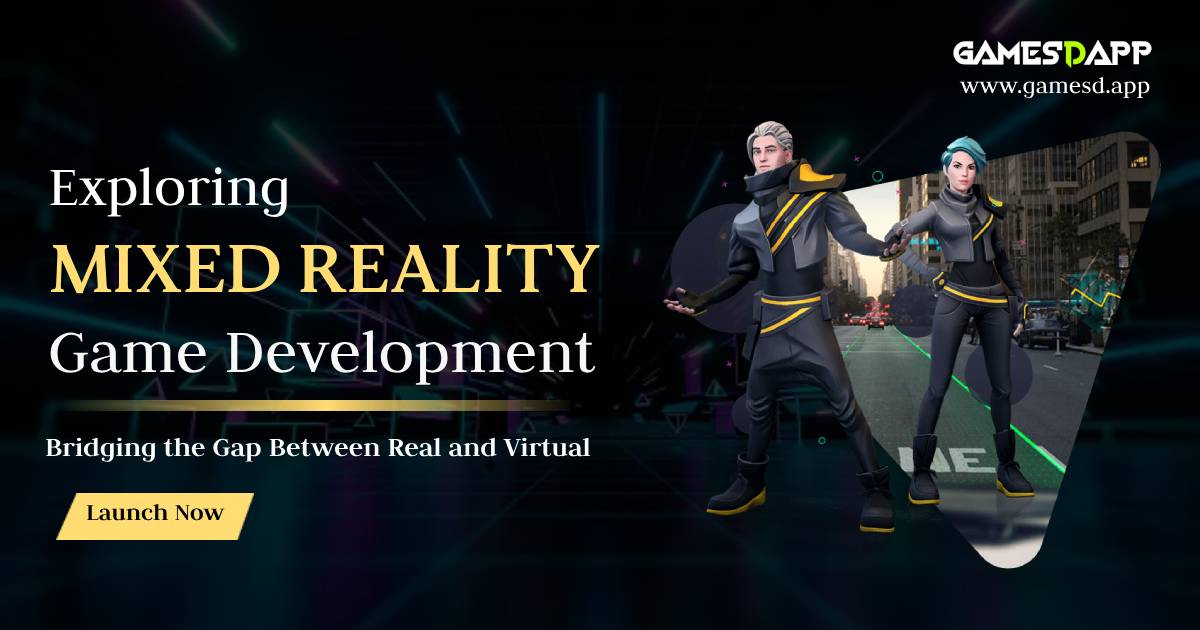Exploring Mixed Reality Game Development: Bridging the Gap Between Real and Virtual
Hey there, fellow gamers and tech enthusiasts! Ever heard of mixing reality with virtual awesomeness? That's where the buzz about mixed reality comes in! Imagine stepping into a game where your living room transforms into an epic battlefield, or where aliens invade your local park – all through the magic of technology.
So, why are we here? Well, we're diving headfirst into the rabbit hole of mixed-reality game development. Yep, we're going to explore the ins and outs of how these mind-boggling experiences are crafted.
You see, mixed reality isn't just another fancy term. It's a wild fusion where your real world and digital fantasies have the coolest crossover episode ever. It's like VR and AR went on a date and had a baby that's part real, part virtual, and all sorts of mind-blowing.
So buckle up, because we're about to uncover what makes mixed reality tick, why it's sending shockwaves through the gaming universe, and what it takes to cook up your very own mixed reality gaming masterpiece. Ready to take the plunge into a world where reality isn't what it seems? Let's do this!
Understanding Mixed Reality Game Development: A Technical Dive
Mixed Reality (MR) game development intricately weaves the tangible world with digital augmentation, utilizing cutting-edge technologies like computer vision and spatial mapping. MR captures real-world surroundings through sensors, seamlessly integrating virtual elements with the physical environment.
Unlike Virtual Reality (VR), MR maintains a link to the real world, allowing natural interaction. Spatial mapping identifies surfaces and objects, enabling precise virtual object placement. Real-time tracking ensures accurate responses to physical movements.
MR development combines languages like C# and C++ with game engines such as Unity or Unreal Engine. Augmented Reality Software Development Kits (AR SDKs) like ARKit and ARCore aid tracking and rendering.
Designers, artists, developers, and UX specialists collaborate to merge virtual and real elements, ensuring seamlessness through rigorous testing. This complex orchestration pioneers interactive gaming, bridging reality and virtual realms for transformative experiences. A fusion of code, art, and engineering reshapes the gaming landscape, redefining reality as tangible and virtual.
Key Features of Mixed Reality
Holistic Integration: Mixed Reality (MR) stands apart by holistically integrating real-world surroundings with virtual entities, facilitating an immersive composite experience.
Spatial Mapping Precision: MR relies on advanced spatial mapping techniques, enabling the accurate digitization and representation of physical environments. This data-driven understanding allows for precise placement and interaction with virtual objects.
Real-time Interaction Dynamics: MR's real-time interaction dynamics enable users to engage with virtual elements in a responsive manner, thanks to intricate sensor arrays and tracking technologies. This intricate choreography of data facilitates natural gestures and actions within the virtual realm.
Depth Perception Engineering: The implementation of depth perception through stereoscopic displays or depth-sensing cameras ensures the spatial alignment of virtual objects within the physical context. This sophisticated calibration delivers a heightened sense of tangibility.
Dynamic Contextual Seamlessness: These features synergize to create a dynamic, contextual, and seamless experience, where virtual elements respect the spatial constraints and visual fidelity of the real world, pushing the boundaries of human-computer interaction.
Distinguishing Mixed Reality, Augmented Reality, and Virtual Reality
| Aspect | Mixed Reality (MR) | Augmented Reality (AR) | Virtual Reality (VR) |
|---|---|---|---|
| Immersion Level |
Blends real and virtual worlds, offering varying degrees of immersion. |
Overlays virtual content onto the real world, maintaining awareness of surroundings. |
Creates a fully immersive, artificial environment disconnected from the physical world. |
| Interaction with Reality |
Interacts with and responds to real-world elements. |
Interacts with real-world objects through digital overlays. |
Isolated from the physical environment, interaction is solely with virtual elements. |
| Hardware Dependency |
Requires specialized hardware like HoloLens, Magic Leap, or advanced VR headsets. |
Utilizes devices like smartphones, tablets, or AR glasses. |
Relies on VR headsets, often connected to computers or standalone systems. |
| Examples |
Microsoft HoloLens merges virtual objects with real environments. |
Pokémon GO superimposes creatures onto real-world locations |
Oculus Rift offers immersive gaming experiences. |
| Use Cases |
Architecture visualization, interactive training simulations. |
Navigation assistance, interactive manuals. |
Gaming, medical training simulations. |
| Spatial Awareness |
Utilizes spatial mapping to anchor virtual objects in real-world locations. |
Recognizes real-world markers or objects to overlay digital content. |
Lacks awareness of the physical environment. |
| Real-World Integration |
Blends real and virtual elements seamlessly for dynamic interaction |
Augments reality with contextual information or virtual objects. |
Creates entirely virtual environments with no real-world integration. |
In summary, Mixed Reality, Augmented Reality, and Virtual Reality represent distinct points on the immersion spectrum, each with its unique applications and user experiences. Mixed Reality stands at the intersection, melding virtual and real elements, Augmented Reality enhances reality with digital overlays, and Virtual Reality immerses users entirely in a virtual realm. Understanding these differences is pivotal for developers and users alike, as they navigate the evolving landscape of immersive technologies.
Is Investing in Mixed Reality Games Worth It? Exploring ROI and Market Prospects
Potential ROI: Despite upfront costs, MR game development yields substantial returns through higher engagement and premium pricing.
Market Prospects: Growing demand for MR experiences, exemplified by hits like Pokémon GO, coupled with affordable hardware expansion.
Strategic Investment: Investing in MR games establishes a foothold in an emerging market with less competition.
Enhanced User Experience: MR games redefine engagement, providing unique experiences that result in longer play sessions and better monetization.
Calculated Risk: Investing in MR games is a calculated move, offering substantial potential in reshaping the gaming landscape.
Partnering with Gamesdapp for Mixed Reality Development: Transforming Ideas into Reality
Embrace innovation and immersion with Gamesdapp, your trusted ally in mixed reality (MR) development. We convert MR visions into captivating experiences that redefine player engagement.
Gamesdapp's skilled developers bring your MR concepts to life. Be it spatial mapping, real-world interactions, or immersive narratives, we ensure a seamless blend of virtual and real.
Partnering with Gamesdapp offers expertise, cutting-edge tools, and a commitment to top-tier MR experiences. Our journey is marked by innovation and a shared passion for gaming evolution.
Choosing Gamesdapp means more than a development team; it's a collaboration that embraces MR's potential. Together, we'll transform your MR concept into reality, offering unmatched immersion and engagement.
Closing Notes
As we conclude our journey through mixed reality (MR) development, the convergence of real and virtual has unveiled boundless opportunities. MR's fusion of realms, spatial precision, and user interaction has reshaped how we perceive technology.
The trio of MR, augmented reality, and virtual reality now stands distinct, their applications and user experiences clear. We've explored the calculated potential of investing in MR games, enticed by engagement and evolving prospects.
Enter the leading game development company - Gamesdapp, your partner in crafting captivating MR experiences. Our innovation, expertise, and cutting-edge tools ensure a transformative reality blend. With Gamesdapp, you're not just embracing MR; you're shaping its evolution. Venture onward into a world where reality transcends boundaries, and virtual becomes tangible.
Get A Demo
Let's Connect With Us







